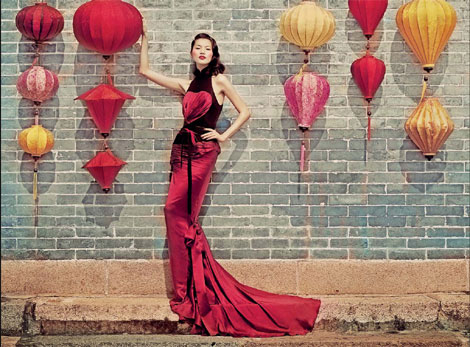China-Europe
A touch of European class
Updated: 2010-12-31 11:19
(China Daily European Weekly)
|
|
Xinlelu, in the heart of the former French Concession in Shanghai, is the place where many of the city's style-setters head for the latest in fashion.
Along the quiet tree-lined street, away from the crowded commercial district of Huaihailu, are numerous boutiques that cater mainly to an exclusive group of clients who know exactly what they want. Many of the owners of these boutiques are fashion designers who learned their trade in Paris or Milan.
Names such as Lilian Zhang and Jenny Ji in fashion, and Wang Yang in product design are well-known among discerning consumers in China. Their style, which combines Chinese traditional elements with European design styles, is known as Hai Pai Wen Hua, which is commonly translated as Mandarin style with an overseas touch.
These Shanghai designers have made a name for themselves in Xinlelu and are emerging as a force that helps shape the trends not only in Shanghai but also in Beijing and other major mainland cities.
If you want to see for yourself what Hai Pai Wen Hua looks like, pay a visit to Zhang's boutique in Xinlelu. It is located on the ground floor of a low-rise apartment building of the 1930s, behind a front yard of potted plants and a small stone fountain.
Zhang has designed the boutique so that customers will feel they have been invited into a friend's walk-in closet. The items inside may not come cheap - a simple vest of Chinese lace, the least expensive item in her shop, will set you back a cool 2,800 yuan (319 euros) - but then you are paying to be chic and unique.
"It's the design that counts," says Zhang, who studied fashion design in London, casually picking up a dress from a rack, holding it against herself and turning around.
"See how naturally and gracefully the dress flows with every movement," she says.
The secret, she adds, is in the cutting and the fabric, which is woven in China with a distinctive Chinese pattern.
She picks another dress from the rack, which, she says, illustrates the distinctive style of Hai Pai Wen Hua.
The dress has the high stiff collar commonly found on the traditional Chinese qipao, which dates back to the Qing Dynasty (1644-1911). The traditional Chinese design detail blends well with the overall design of the dress, which is in a modern European style.
Hai Pai Wen Hua dresses are also proving popular with advertisers. Giant posters of a slim, tall, young Chinese woman in a full-length black and red European-styled evening gown with Chinese characteristics have recently been shown in Fuxing Park in Shanghai. The dress was designed by Shanghai designer Jenny Ji.
"I have been experimenting with infusing Chinese culture into European-style cuts and textures for a long time. This is, as far as I am concerned, the best way to demonstrate the Hai Pai Wen Hua school of design unique to Shanghai," she says.
The dress emphasizes the model's "femininity" and "confidence", which are the essential attributes of a traditional Chinese woman from the Mandarin class, Ji says, adding that she wanted to recreate the same image for modern Chinese women now China has "regained its rightful place on the world stage through economic development".
Ji majored in economics at university, but decided to pursue her interest in fashion after graduation and landed a job in Hong Kong assisting a Japanese designer at a prominent apparel company.
But working as an assistant did not satisfy her and she quit and moved to Milan to study fashion at the well-established design school Marangoni. Upon her return to Shanghai, Ji launched her own fashion brand "La Vie" in 2002. It is essentially haute couture. The brand was later well received in France and Belgium and attracted media coverage by The New York Times in 2006 and CNBC in 2008.
It is the simplicity of the best European designs, which interests Ji.
"There are too many lines and curves in Gothic or Baroque designs. There used to be similar designs in China in the past, which are way too complicated for me. The modern European designs, which are known for their simplicity and practicality, are more to the taste of customers nowadays," she says.
Even priced at 20,000 yuan, her wedding gowns have attracted great interest.
"The wedding ceremony is a lifetime event for most people. Though not cheap, most professionals are willing to spend this amount of money to make this stage of their lives memorable," she says.
Ji has an exclusive supply of a handmade material from London, which can be dated back to 1835.
"As long as we are making haute couture, we should strive to give our customers as many exclusive rights as possible. Therefore, we are trying to import first class materials from Europe as well as learning their advanced design trends and patterns," Ji says.
The European influence on Shanghai and China is not limited to just fashion. Many luxury homes in Shanghai are furnished with elegant Italian furniture, functional German kitchenware and lavish French fabrics. And an increasing number of product designers are exploring the Chinese market with a broader international vision.
Wang Yang, a product designer based in Shanghai, majored in traditional Chinese painting at university. Upon graduation, she went to Germany to pursue her interest in product design and lived there for more than six years. Wang returned to Shanghai in 2006 and established her own company Kieferzapfen Design the same year. Her design brand YAANG was registered in 2007.
"For anyone who has lived in Germany for six years, it is really hard to resist the influence of their culture," Wang says.
However, she admits that some German designs might not appeal to Chinese customers.
"To peel asparagus, some German designer came up with a peeler, which only peels asparagus. This product may be welcomed by German consumers but for Chinese people it may seem very uneconomical, for it only serves that one purpose. So keeping in mind the difference in lifestyles among different countries and regions is the key to success for designers," says Wang.
Wang believes that more designers studying abroad will help to boost the design industry in China.
"You will be surprised to find that European designers are more proficient in embroidering Chinese elements into their designs. It is because the European designers see our culture in a different way and that is a really important lesson," she says.
"To learn the essence of European design will help Chinese designers use Chinese elements in better and smarter ways."
Jenny Ji said that Chinese designers who are starting their careers should resist the urge to just copy the European designs.
"Changle Street in Shanghai has been receiving growing popularity among people with a desire for designed products. But those with some knowledge of the international design field will easily see that some of the shops on the street are just copying everything by lesser-known European design brands," Ji says.
Professor Jan Stael von Holstein, who lectures on design creativity at Shanghai Tongji University , says that China made a name for itself in calligraphy, porcelain, jade, furniture and fabrics in the past, but nowadays it lacks a distinctive style of its own.
"It is time for the country to invent its own style," he says.
E-paper

Pearl paradise
Dreams of a 'crazy' man turned out to be a real pearler for city
Literary beacon
Venice of china
Up to the mark
Specials

Power of profit
Western companies can learn from management practices of firms in emerging economies

Test of character
Keyboard-dependent Chinese are returning to school because they have forgotten how to write

Foreign-friendly skies
About a year ago, 48-year-old Roy Weinberg gave up his job with US Airways, moved to Shanghai and became a captain for China's Spring Airlines.

